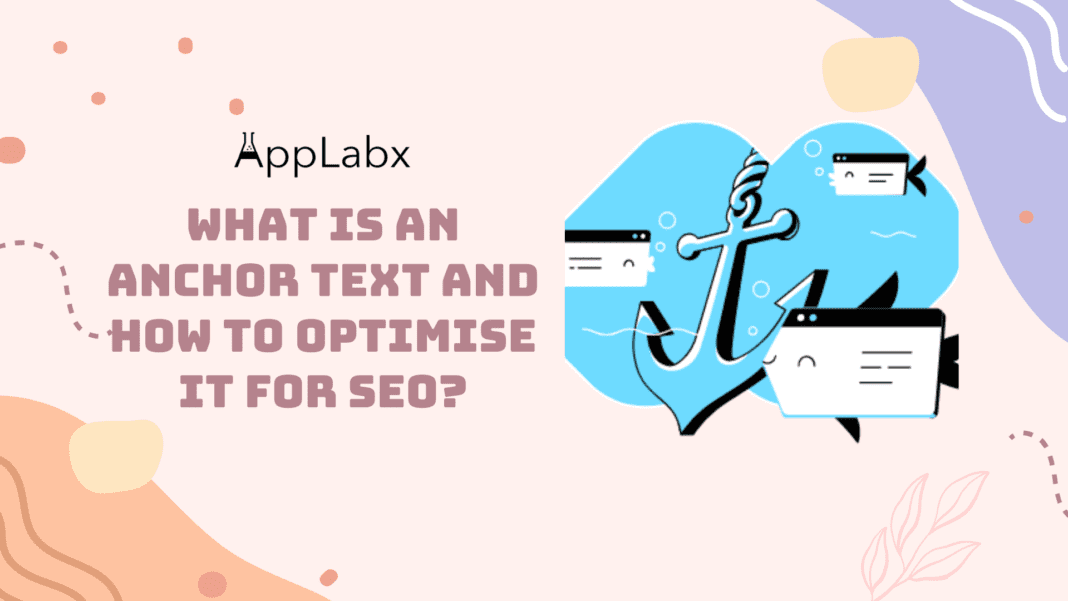Key Takeaways
- Precision Matters: Align anchor text with target keywords, striking a balance between exact match, partial match, branded, and generic types for effective SEO.
- Context is Key: Integrate anchor text seamlessly into content, prioritizing relevance to user intent. Contextual links enhance user experience and search engine understanding.
- Future-Proof Strategies: Embrace evolving trends like contextual relevance, AI integration, and mobile-first considerations for a robust anchor text optimization strategy. Stay adaptable in the dynamic landscape of SEO.
In the vast realm of Search Engine Optimization (SEO), where every pixel and character counts, one particular element stands out as a linchpin for enhancing visibility and driving organic traffic: Anchor Text.
In the intricate tapestry of hyperlinks that weave through the web, anchor text serves as the beacon guiding search engines through the labyrinth of content. But what exactly is anchor text, and why does it wield such influence in the digital landscape?

Unveiling the Mysteries of Anchor Text
At its core, anchor text refers to the clickable text within a hyperlink.
It serves as a signpost, providing users and search engines with a glimpse into the content they are about to explore.
However, its significance extends far beyond mere navigational assistance.
Anchor text plays a pivotal role in SEO, acting as a crucial signal for search engine algorithms to decipher the relevance and context of linked content.
The Multifaceted World of Anchor Text: Types and Significance
Not all anchor texts are created equal.
Understanding the nuances of each type is akin to wielding a powerful tool in the SEO arsenal.
From the precision of Exact Match Anchor Text to the subtlety of Branded and Generic variations, the choices made in anchor text selection can either catapult a webpage to the zenith of search results or consign it to the abyss of digital obscurity.
Navigating this landscape requires a strategic approach. How does one strike the delicate balance between relevance and diversity?
How can anchor text optimization be wielded for maximum impact without falling prey to the pitfalls of over-optimization?
These questions lay the foundation for a comprehensive exploration into the art and science of anchor text optimization.
The SEO Alchemy: Best Practices for Anchor Text Optimization
Embarking on the journey of anchor text optimization necessitates a keen understanding of the best practices that underpin its effectiveness.
It’s not merely about sprinkling links liberally across content; it’s about crafting a seamless integration that enhances user experience while aligning with the ever-evolving algorithms of search engines.
In the labyrinth of SEO strategies, relevance emerges as the guiding star. How can anchor text be seamlessly woven into content, aligning with target keywords and providing value to the reader?
Diversification becomes the compass, ensuring a delicate equilibrium between exact match and other anchor text types. The quest for naturalness echoes through every keystroke, cautioning against the perils of keyword stuffing.
But the optimization journey doesn’t end within the confines of a single webpage. Internally and externally, linking strategies come into play, adding layers of complexity to the SEO tapestry.
As we delve into the intricacies, we’ll uncover the secrets of utilizing anchor text for internal navigation and the nuanced approach required for external linking that transcends the ordinary.
Equipping the SEO Explorer: Tools for Anchor Text Optimization
In the ever-evolving landscape of SEO, tools emerge as indispensable companions for the digital explorer.
From advanced analytics tools that dissect the intricacies of anchor text usage to suggestion tools that illuminate the path forward, a comprehensive toolkit awaits those ready to harness the power of anchor text optimization.
Gazing into the Future: Trends in Anchor Text Optimization
The SEO landscape is a dynamic realm, with algorithms evolving and user behaviors shifting.
What lies on the horizon for anchor text optimization?
How will the symbiotic dance between search engines and anchor text adapt to the ever-changing digital ecosystem?
Peering into the crystal ball, we’ll explore the future trends that will shape the destiny of anchor text in SEO.
Navigating the Seas of Anchor Text Optimization
As we embark on this odyssey through the world of anchor text and its optimization for SEO, the compass is set, and the sails are unfurled.
From unraveling the mysteries to crafting a roadmap for the future, this exploration aims to equip digital navigators with the knowledge and insights needed to chart a course toward SEO success.
So, fasten your seatbelts, or rather, secure your anchors – the journey into the heart of SEO optimization awaits.
But, before we venture further, we like to share who we are and what we do.
About AppLabx
From developing a solid marketing plan to creating compelling content, optimizing for search engines, leveraging social media, and utilizing paid advertising, AppLabx offers a comprehensive suite of digital marketing services designed to drive growth and profitability for your business.
AppLabx is well known for helping companies and startups use SEO marketing to drive web traffic to their websites and web apps.
At AppLabx, we understand that no two businesses are alike. That’s why we take a personalized approach to every project, working closely with our clients to understand their unique needs and goals, and developing customized strategies to help them achieve success.
If you need a digital consultation, then send in an inquiry here.
What is an Anchor Text and How to Optimise it for SEO?
- Types of Anchor Text
- Best Practices for Optimizing Anchor Text
- Tools for Anchor Text Optimization
- Future Trends in Anchor Text Optimization
1. Types of Anchor Text

Types of Anchor Text
In the intricate dance of SEO, the various types of anchor text wield distinct influences on search engine algorithms.
Understanding the nuances of each type is paramount to crafting a finely tuned-optimization strategy.
Exact Match Anchor Text
Exact match anchor text involves using the exact keyword phrase as the clickable text.
While seemingly straightforward, its potency lies in its direct alignment with the target keyword.
For instance, in a blog about “best SEO practices,” an exact match anchor text could be: <a href="yourlink.com">best SEO practices</a>.
Benefits
- Provides a clear signal of content relevance to search engines.
- Enhances keyword targeting for the linked page.
Caution
- Prone to over-optimization if used excessively.
- May appear unnatural if not seamlessly integrated into the content.
Partial Match Anchor Text
Partial match anchor text involves incorporating a variation of the target keyword.
This allows for a degree of flexibility while maintaining relevance.
For example, in an article about “healthy eating habits,” a partial match anchor text could be: <a href="yourlink.com">tips for maintaining healthy eating habits</a>.
Benefits
- Offers a balance between precision and natural language.
- Reduces the risk of over-optimization.
Caution
Careful consideration is needed to maintain relevance.
Branded Anchor Text
Branded anchor text incorporates the brand name as the clickable element.
This type fosters brand recognition and trust.
In a scenario where the brand is “HealthyHarvest,” the branded anchor text could be: <a href="yourlink.com">Explore HealthyHarvest's latest products</a>.
Benefits
- Reinforces brand identity and authority.
- Provides a natural and user-friendly experience.
Caution
Should be used strategically to maintain a balance with keyword-focused anchors.
Naked URL Anchor Text
Naked URL anchor text involves displaying the full URL as clickable text without any additional keywords.
This straightforward approach can be effective in certain contexts. For instance: <a href="https://yourlink.com">Visit our latest collection here</a>.
Benefits
- Simplifies the user experience by displaying the destination URL.
- Suitable for promoting brand-specific landing pages.
Caution
Limited keyword targeting.
Generic Anchor Text
Generic anchor text uses non-specific, often non-descriptive phrases as the clickable element.
While less focused on keywords, it contributes to a natural link profile. An example could be: <a href="yourlink.com">Read more here</a>.
Benefits
- Appears natural and user-friendly.
- Reduces the risk of over-optimization.
Caution
Limited keyword relevance.
The Landscape of Anchor Text Usage: Statistics and Insights
Navigating the landscape of anchor text types is not only about understanding their nature but also about adapting to the trends shaping the digital horizon.
Here are some noteworthy statistics and insights:
Diversity in Anchor Text Distribution
Over-reliance on exact match anchors has shown a decline in effectiveness, emphasizing the importance of diversity.
Impact of Over-Optimization
Google’s algorithm updates, including Penguin, target over-optimized anchor text as a potential indicator of spammy tactics.
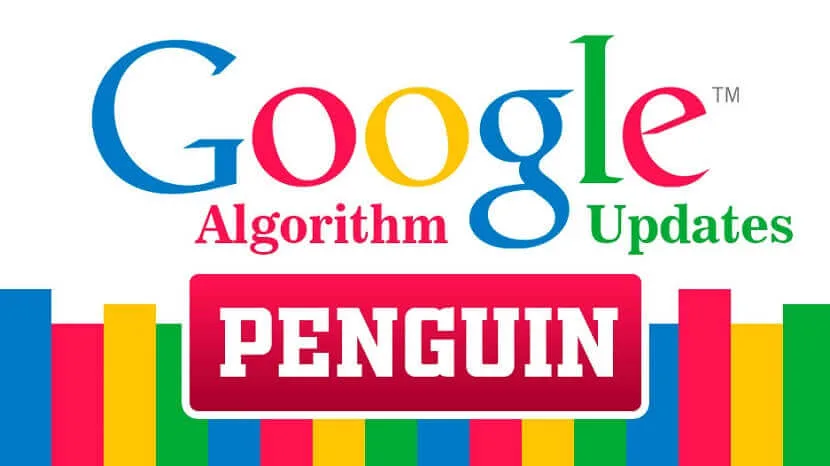
Evolving Preferences in Linking
Users are increasingly responding favourably to contextually relevant anchor text that enhances the overall reading experience.
2. Best Practices for Optimizing Anchor Text

Relevance to Content
Crafting anchor text that seamlessly integrates with the content is not just an art; it’s a science that requires precision and finesse.
Here are the best practices to ensure relevance to your content:
Aligning with the Target Keyword
- Keyword Alignment Statistics:
- Pages with at least one exact match anchor from an internal link have significantly higher traffic.
- However, it’s crucial to maintain a balance to avoid over-optimization.
- Strategic Keyword Placement:
- Place anchor text where it naturally fits within the content, ensuring it enhances the reader’s understanding of the linked topic.
- For example, in a blog about “healthy meal plans,” an anchor text like “explore nutritious recipes” strategically aligns with the content.
Contextual Placement
- Content Context and Anchor Text:
- Google’s algorithms increasingly prioritize context. Ensure that the anchor text flows naturally within the context of the surrounding content.
- Example: In a fitness article, an anchor text like “discover effective workout routines” is contextually relevant.
- Surrounding Text Optimization:
- Optimize the text surrounding the anchor to reinforce the relevance of the link. Use descriptive language that aligns with the anchor text theme.
Diversification of Anchor Text
Maintaining a diverse anchor text profile is essential for a natural-looking link profile.
Here’s how to achieve a healthy balance:
Balancing Exact Match and Other Types
- Percentage Distribution: Avoid relying too heavily on one type to mitigate the risk of over-optimization.
- Natural Language Variation:
- Embrace natural language in anchor text. Google’s algorithms increasingly favor a conversational and user-friendly approach.
- Example: Instead of “best SEO practices,” consider “tips for effective SEO.”
Avoiding Over-Optimization
- Over-Optimization Risks:
- Google’s Penguin algorithm penalizes sites employing aggressive over-optimization strategies.
- Keep anchor text usage natural and diverse to avoid triggering penalties.
- Link Velocity Control:
- Manage the speed at which new backlinks are acquired. An unnatural spike in link velocity can raise red flags.
- Diversify the sources and gradually build links over time.
Natural Anchor Text
Creating anchor text that feels natural to readers while maintaining SEO benefits requires finesse.
Here are the best practices:
Writing for Readers, Not Just Search Engines
- User-Centric Language:
- Craft anchor text with the user in mind. Prioritize language that resonates with the audience.
- Example: Instead of “click here,” use “explore our comprehensive guide.”
- Reader-Friendly Flow:
- Ensure the anchor text doesn’t disrupt the flow of the content. It should enhance, not interrupt, the reading experience.
Avoiding Keyword Stuffing
- Keyword Stuffing Impact:
- Keyword stuffing in anchor text can lead to penalties. Google’s algorithms are adept at identifying unnatural language.
- Maintain a natural keyword density, focusing on readability.
- Contextual Keyword Integration:
- Integrate keywords contextually within the anchor text. It should feel like a seamless part of the sentence or phrase.
Internal and External Linking Strategies
Strategic linking practices enhance the overall structure of a website. Here’s how to optimize internal and external links through anchor text:
Utilizing Anchor Text for Internal Links
- Anchor Text Hierarchy:
- Establish a hierarchy for internal anchor text. Priority should be given to key pages, emphasizing their importance.
- Example: In an e-commerce site, anchor text like “best-selling products” can lead to a high-converting page.
- Consistent Theme Reinforcement:
- Use consistent anchor text themes for related internal links. It aids in establishing topical relevance and strengthens the site’s structure.
Implementing Best Practices for External Links
- Quality External Link Sources:
- Choose reputable and authoritative sources for external links. It reflects positively on your site’s credibility.
- Example: If referencing a study, use the study’s title or a descriptive phrase as anchor text.
- Link Context and Relevance:
- Ensure external anchor text aligns with the linked page’s content. This contributes to a cohesive and meaningful user experience.
3. Tools for Anchor Text Optimization
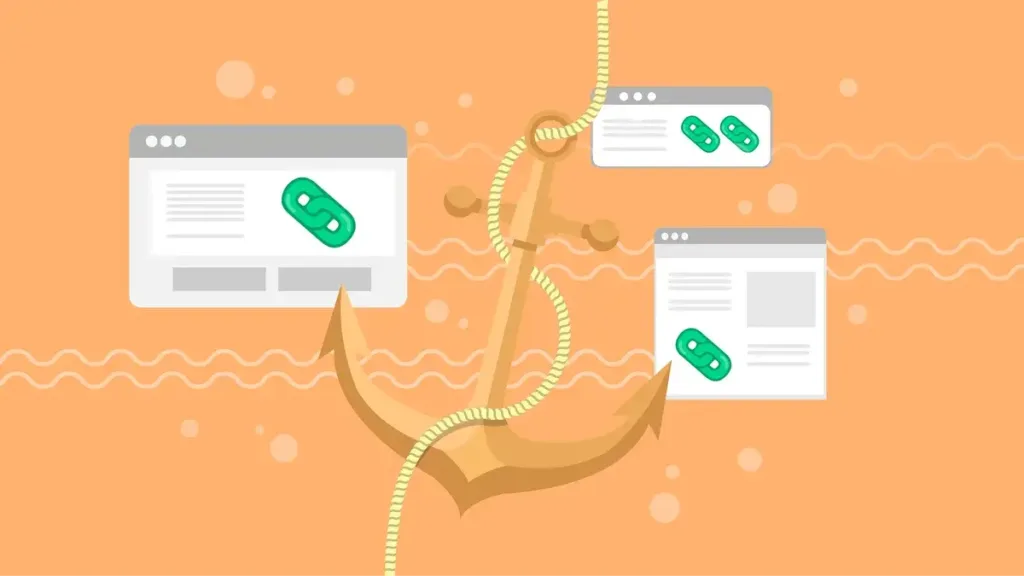
SEO Tools for Analyzing Anchor Text
Harnessing the power of specialized SEO tools is essential for in-depth analysis and optimization of anchor text.
Here are some leading tools tailored for analyzing anchor text:
Ahrefs
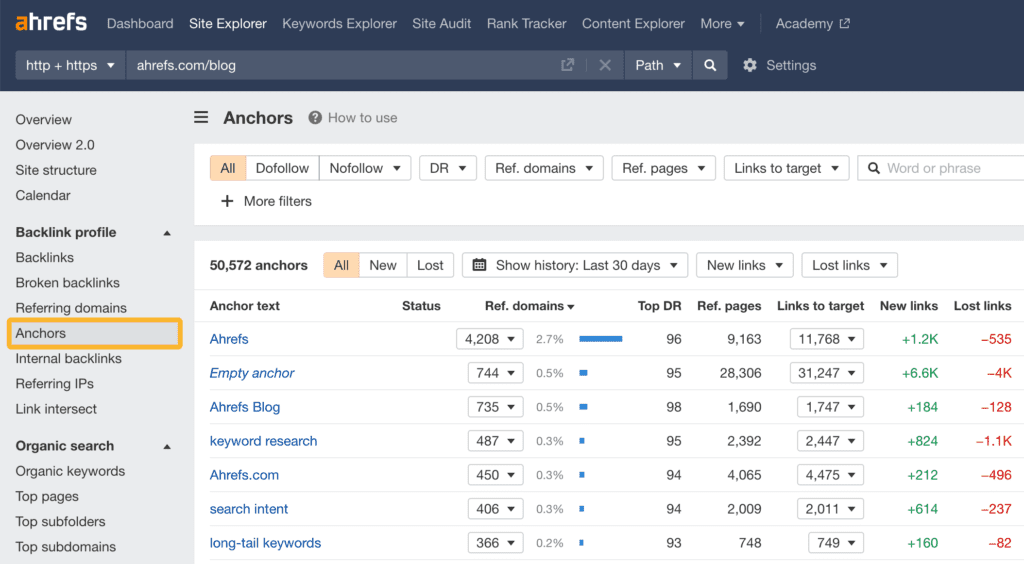
- Comprehensive Anchor Text Insights:
- Ahrefs offers a detailed breakdown of anchor text distribution, allowing users to assess the percentage of exact match, partial match, branded, and generic anchors.
- The tool’s Backlink Checker provides a comprehensive overview of a website’s linking profile.
- Competitor Analysis:
- Ahrefs allows users to analyze competitor anchor text strategies, providing valuable insights for refining one’s own approach.
- This feature aids in benchmarking against industry leaders and identifying opportunities for improvement.
Semrush
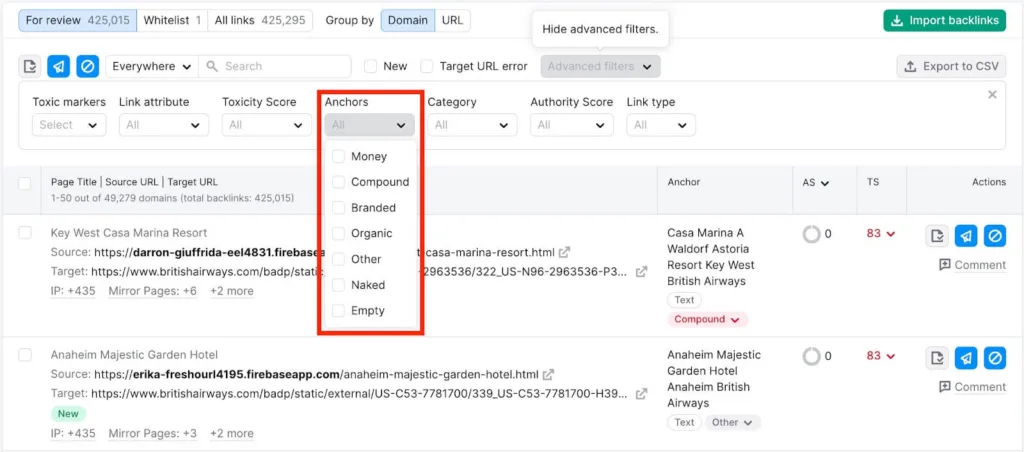
- Anchor Text Analysis and Suggestions:
- Semrush provides a robust anchor text analysis feature that not only identifies existing anchors but also suggests improvements for a balanced and effective strategy.
- The tool offers insights into the distribution of different anchor text types.
- Competitive Landscape Overview:
- Semrush enables users to assess the anchor text strategies of competitors, helping to refine and differentiate one’s own approach.
- This competitive intelligence is invaluable for staying ahead in the SEO game.
Anchor Text Suggestion Tools
Crafting effective anchor text often involves striking a balance between optimization and natural language. Here are tools designed to assist in generating contextually relevant anchor text:
Surfer SEO

- Competitor-Based Anchor Text Optimization:
- Surfer SEO employs competitor analysis to provide insights into effective anchor text strategies.
- By understanding what works in a specific niche, users can optimize their own anchor text for better performance.
- Data-Driven Suggestions:
- The tool utilizes data-driven approaches to suggest anchor text, aligning with both SEO best practices and user intent.
- Surfer SEO’s suggestions are rooted in comprehensive data analysis and industry trends.
4. Future Trends in Anchor Text Optimization

Evolving Search Engine Algorithms
The future of anchor text optimization is intricately tied to the dynamic nature of search engine algorithms.
As search engines continuously refine their methods for delivering relevant results, staying ahead of the curve requires an understanding of evolving trends:
Contextual Relevance as a Ranking Factor
- Emergence of BERT Algorithm:
- Google’s BERT (Bidirectional Encoder Representations from Transformers) algorithm, introduced in 2019, marked a significant shift toward understanding the context of words in a search query.
- BERT aims to comprehend the nuances of language, considering the context in which words appear.

- Impact on Anchor Text Optimization:
- Future anchor text strategies need to prioritize contextual relevance. Linking should align seamlessly with the surrounding content to satisfy the intent behind user queries.
- Example: Instead of focusing solely on keywords, anchor text should contribute meaningfully to the topic being discussed.
AI and Machine Learning Integration
- Role of AI in Search Algorithms:
- Search engines are increasingly incorporating AI and machine learning to enhance user experience and refine search results.
- These technologies allow algorithms to adapt and learn from user behavior, evolving over time.
- Adaptive Anchor Text Strategies:
- AI-driven algorithms can analyze user interactions with anchor text and adapt strategies accordingly.
- Future optimization will involve leveraging AI tools to dynamically adjust anchor text based on evolving user preferences and search engine algorithms.
User Experience and Its Impact on Anchor Text
In the future, user-centric approaches will play a pivotal role in determining the effectiveness of anchor text optimization.
Enhancing user experience is not only a ranking factor but also a key element in shaping future trends:
User Engagement Metrics
- Dwell Time and Click-Through Rates:
- Search engines increasingly consider metrics like dwell time (the time a user spends on a page) and click-through rates as indicators of content relevance.
- Future anchor text strategies should aim at encouraging user engagement and reducing bounce rates.
- Anchor Text’s Contribution to Engagement:
- Relevant and enticing anchor text can contribute to higher click-through rates, signaling to search engines that the linked content aligns with user expectations.
- Example: Engaging anchor text that sparks curiosity may lead to increased click-through rates.
Mobile-First Indexing

- Mobile-First Approach by Search Engines:
- Google’s mobile-first indexing prioritizes mobile versions of websites, considering the increasing prevalence of mobile device usage.
- The user experience on mobile devices becomes a critical factor in rankings.
- Responsive Anchor Text:
- Future anchor text strategies should account for the mobile user experience, ensuring that clickable text is concise, clear, and suitable for smaller screens.
- Example: Short and impactful anchor text that fits well within the constraints of mobile interfaces.
Conclusion
In the intricate world of Search Engine Optimization (SEO), the anchor text stands as a pivotal element, guiding both users and search engines through the digital landscape.
Defined as the clickable text within a hyperlink, anchor text plays a significant role in signaling the relevance and context of linked content.
Our exploration into “What is an Anchor Text and How to Optimize it for SEO” began with the recognition of its fundamental importance in the realm of digital visibility.
Navigating the Seas of Anchor Text Types: Precision and Diversity
Our journey took us through the diverse types of anchor text, each with its unique characteristics and impact on SEO.
From the precision of exact match anchors to the subtlety of branded and generic variations, we delved into the nuances that define effective anchor text.
Balancing the diversity of anchor text types emerged as a strategic imperative, steering us away from the perils of over-optimization and toward a holistic approach.
Crafting Anchor Text Strategies: Best Practices for Optimization
In the ever-evolving landscape of SEO, the adoption of best practices for anchor text optimization became our compass.
Aligning anchor text with target keywords, seamlessly integrating it into the context of the content, and prioritizing relevance to user intent were established as key strategies.
Diversification of anchor text types, a nod toward natural language, and a mindful approach to internal and external linking emerged as the cornerstones of a successful optimization journey.
Tools of the Trade: Leveraging Technology for Optimization
Our exploration was enhanced by the utilization of cutting-edge SEO tools designed to dissect, analyze, and optimize anchor text. Ahrefs and Semrush provided comprehensive insights into anchor text distribution and competitive analysis.
Linkio and Surfer SEO emerged as valuable assistants, offering suggestions and strategies to create a diverse and contextually relevant anchor text profile.
These tools, akin to a digital sextant and compass, equipped digital navigators with the precision needed for effective optimization.
Peering into the Future: Emerging Trends in Anchor Text Optimization
As our voyage progressed, we set our sights on the horizon of future trends in anchor text optimization. The emergence of algorithms like BERT underscored the growing importance of contextual relevance in anchor text.
The integration of AI and machine learning signaled a shift toward adaptive optimization strategies. User experience became a guiding star, influencing metrics like dwell time and click-through rates.
Responsive anchor text, aligned with the mobile-first approach, became a vital consideration for future success.
Setting Sail Toward SEO Success: A Continuous Expedition
In conclusion, our exploration of anchor text optimization is not the end but a waypoint in a continuous expedition.
Armed with knowledge, guided by best practices, and equipped with innovative tools, digital navigators are poised to navigate the ever-shifting currents of SEO.
The seas of optimization are dynamic, influenced by algorithms, user behaviors, and technological advancements. As we set sail into the horizon, let us embrace the wisdom gained from optimizing anchor text.
With relevance, diversification, and user-centricity as our guiding principles, we navigate toward success, adapting to the winds of change and riding the waves of innovation in the vast and boundless realm of search engine optimization. Bon voyage.
If you are looking for a top-class digital marketer, then book a free consultation slot here.
If you find this article useful, why not share it with your friends and business partners, and also leave a nice comment below?
We, at the AppLabx Research Team, strive to bring the latest and most meaningful data, guides, and statistics to your doorstep.
To get access to top-quality guides, click over to the AppLabx Blog.
People also ask
How do I optimize anchor text for SEO?
Optimize anchor text for SEO by aligning it with target keywords, ensuring relevance to content. Diversify with a mix of exact match, partial match, branded, and generic anchors. Prioritize natural language, integrate seamlessly into context, and use reputable tools for analysis and refinement.
What is an anchor in SEO?
In SEO, an anchor is the clickable text in a hyperlink. It provides context to search engines, guiding them on the linked page’s content. Optimizing anchor text is crucial for relevance and ranking, aligning with target keywords and enhancing user experience.
Does anchor text matter for SEO?
Absolutely, anchor text matters for SEO. It provides context to search engines about linked content, influencing rankings. Well-optimized anchor text, aligned with target keywords and content relevance, enhances a page’s visibility and user experience, impacting overall SEO success.
What is anchor text in SEO?
Anchor text is the clickable text in a hyperlink that directs users to another webpage. It plays a crucial role in SEO by providing context to search engines about the content of the linked page.
How does anchor text affect SEO?
Anchor text helps search engines understand the relevance and topic of the linked page. Optimizing anchor text with relevant keywords can improve the ranking of the linked page for those keywords.
What are the types of anchor text?
Anchor text can be categorized into different types, including exact match, partial match, branded, and naked URLs. Each type serves a specific purpose in SEO strategy.
How can I optimize anchor text for SEO?
Optimize anchor text by using relevant keywords that accurately describe the linked page’s content. Ensure diversity in anchor text types and avoid over-optimization to maintain a natural link profile.
What are some best practices for using anchor text?
Use descriptive anchor text that provides value to users and accurately reflects the linked content. Also, vary anchor text to avoid appearing spammy and prioritize user experience over SEO tactics.
What mistakes should I avoid when optimizing anchor text?
Avoid using generic or irrelevant anchor text, as well as excessive keyword stuffing. Additionally, refrain from using too many exact match anchor texts, which can trigger penalties from search engines.


























